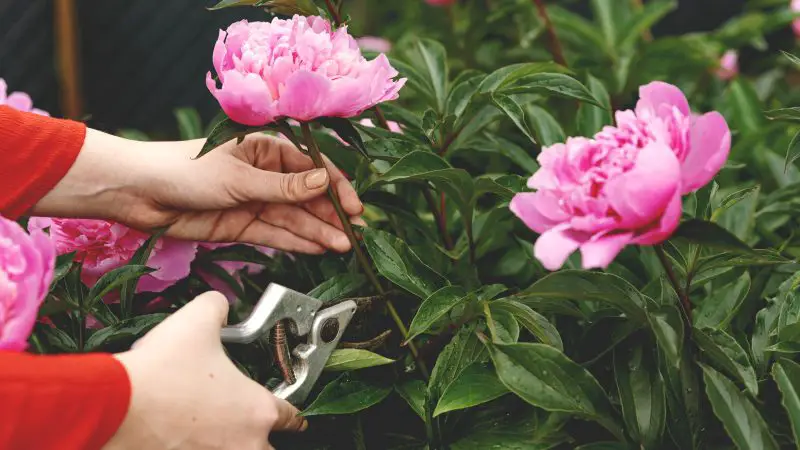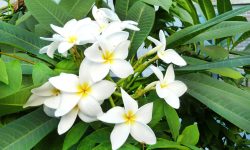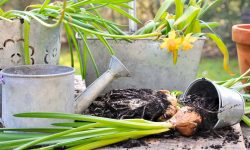Peonies are among the most cherished flowers in home gardens, admired for their lush, ruffled petals and enchanting fragrance. Their brief but stunning bloom season makes them even more precious, and gardeners often seek ways to prolong their beauty or enhance flowering in the following year. One important maintenance task that can influence the overall performance of peonies is deadheading. When done correctly, deadheading helps redirect the plant’s energy, maintains a neat appearance, and encourages healthier growth.
This comprehensive guide dives into how to deadhead peonies the right way for more blooms, while also exploring the science behind the process, tools needed, timing considerations, and aftercare techniques to keep your peonies thriving season after season.
Understanding the Purpose of Deadheading Peonies

Deadheading, in essence, is the removal of spent or faded blooms from a plant. For peonies, especially herbaceous and intersectional types, this practice serves several important functions. Once a peony finishes blooming, it may begin forming seed heads. Producing seeds requires considerable energy, and by removing the spent flowers, you help the plant conserve energy for root development and foliage maintenance, both of which are crucial for next year’s flowering potential.
In addition, deadheading keeps the garden looking tidy. Brown, withered blooms can detract from the overall beauty of a flowering bed. Removing them enhances the ornamental appeal of your garden while also improving air circulation around the plant, which can help prevent diseases.
While deadheading peonies may not result in repeat blooms during the same season—since peonies typically bloom only once—it can significantly impact the plant’s vigor and the quality of blooms in the following spring. When performed regularly and properly, it supports the peony’s natural cycle of renewal and resilience.
Identifying the Right Time to Deadhead Peonies
The timing of deadheading peonies is essential to ensure you don’t inadvertently hinder the plant’s development. Deadheading should only be done once the bloom has fully finished its flowering cycle. You’ll know it’s time to deadhead when the petals begin to wilt, turn brown, or fall away easily from the center of the flower.
It’s important not to rush this process. Removing blooms that are still viable or only slightly faded can reduce the overall display and possibly interrupt the plant’s ability to gather energy from the flower’s photosynthetic parts. Waiting until the flowers are truly spent allows the plant to gain the most benefit before transitioning energy away from reproduction.
In most climates, peonies bloom in late spring to early summer. Depending on your USDA hardiness zone and specific variety, you may see blooms anytime from April through June. Observing your peonies closely during this time will help you act promptly and correctly when it’s time to deadhead.
Choosing the Right Tools for the Job
Having the proper tools makes deadheading peonies both easier and more effective. A pair of clean, sharp garden shears or pruning scissors is ideal for snipping off spent blooms without damaging the surrounding foliage or stems. Dull or dirty tools can crush stems, introduce disease, or leave ragged edges that invite pests.
Before starting, it’s wise to sterilize your pruning tools with a simple solution of isopropyl alcohol or a diluted bleach mixture. This helps prevent the spread of fungal spores or bacteria from one plant to another. After every few cuts, especially if you’re working on multiple plants, re-sanitizing your tools can provide extra protection.
Gloves can also be helpful, especially for larger peony varieties with dense foliage. Not only do gloves protect your hands from potential irritants, but they also offer a better grip when handling heavier stems or maneuvering around tight flower clusters.
How to Deadhead Peonies Correctly
Deadheading peonies involves more than just snipping off the top of the flower. To do it correctly, begin by locating the spent bloom. Follow the stem down until you find the first set of full, healthy leaves beneath the flower head. This is where you want to make your cut.
Using your sanitized shears, make a clean, angled cut just above those leaves. This angled cut allows water to run off easily, reducing the chance of rot or fungal infection. Avoid leaving a long stem stub above the leaves, as it can become a target for pests or decay.
If the entire stem is weak, yellowing, or beginning to die back after blooming, you can cut it back further—down to the base of the plant or to a strong side shoot. However, this should be done with care, as removing too much green foliage can hinder photosynthesis and weaken the plant overall.
Keep in mind that deadheading peonies is not about drastically cutting them back. The focus should remain on removing only what is necessary—namely the faded flower head and any immediate dead tissue—while preserving healthy leaves that support the plant’s growth.
The Role of Foliage After Deadheading
After the blooms are removed, peony foliage plays a vital role in the plant’s post-bloom phase. The broad, glossy leaves are key to collecting sunlight and converting it into energy that fuels root development and storage for the next blooming cycle.
It’s important not to cut back the foliage prematurely, even if the blooms are long gone. Allowing the leaves to remain intact and healthy until the end of the growing season enables the plant to replenish its energy stores effectively. In fact, many peony growers recommend leaving the foliage in place until it naturally begins to yellow and wither in the fall.
Only then should the remaining stems and leaves be pruned down, typically to about one or two inches above the soil line. This final fall cleanup helps prevent the spread of diseases and allows the plant to go into dormancy in a clean, healthy state.
Deadheading Tree Peonies vs. Herbaceous Peonies
While deadheading practices are similar across peony types, there are subtle differences between herbaceous and tree peonies. Herbaceous peonies die back completely to the ground each winter, and their stems are soft and green. After flowering, deadheading is typically done by cutting the bloom stem just above a leaf joint, as previously described.
Tree peonies, however, are woody shrubs that maintain their stems year-round. Their blooms appear on older wood and sometimes on new growth, depending on the variety. When deadheading tree peonies, you should still remove the faded flower by cutting just above the first set of leaves or side buds beneath the bloom. But because of their woody nature, pruning must be done more carefully to avoid damaging the structure of the plant.
It’s also worth noting that some gardeners prefer to let a few seed pods develop on tree peonies, as their ornamental pods can add interest to the summer garden. However, for those focused on maximum bloom production the following year, removing seed heads remains the best approach.
Post-Deadheading Peony Care Tips
Once deadheading is complete, your peonies benefit from attentive care throughout the rest of the season. Regular watering, especially during dry spells, is essential to support healthy foliage and root development. Peonies prefer moist but well-drained soil and do not tolerate soggy conditions well, so watering should be balanced and consistent.
Applying a layer of mulch around the base of the plant can help conserve moisture, suppress weeds, and moderate soil temperature. Be careful not to pile mulch directly against the crown, as this can lead to rot. Instead, leave a small gap around the stems for air circulation.
Fertilization after blooming can also be beneficial. A balanced, slow-release fertilizer or compost added in mid- to late-summer can help replenish nutrients and prepare the plant for the next season. Avoid high-nitrogen fertilizers, which may promote leafy growth at the expense of strong roots or future flowers.
Additionally, keeping the area around your peonies free from fallen petals and debris reduces the risk of fungal diseases like botrytis blight. This common peony ailment can thrive in moist, decaying organic matter and damage stems and leaves if not managed promptly.
How Deadheading Affects Next Year’s Bloom
Although peonies are not repeat bloomers in a single season, deadheading has a significant effect on the quantity and quality of blooms in the year to come. By removing spent flowers and preventing seed development, the plant can concentrate on building stronger root systems and storing more energy.
This stored energy is used during dormancy to prepare buds that will emerge in spring. Peonies often form their flower buds during late summer or early fall, so ensuring that the plant remains vigorous after blooming is crucial. Deadheading plays a direct role in this process by removing energy-draining seed heads and encouraging the development of next year’s flower-producing shoots.
Peonies that are properly deadheaded and well-maintained typically show more robust growth and larger, more numerous blooms in the following season. Over time, consistent deadheading becomes part of a long-term strategy to maintain healthy, flourishing peony plants.
Common Mistakes to Avoid When Deadheading Peonies
While deadheading is a simple process, it’s not immune to missteps. One common mistake is removing healthy foliage along with the spent bloom. As previously noted, the leaves are crucial for energy production, and cutting too much can weaken the plant. Always target the flower stem just above the topmost set of leaves.
Another issue is deadheading too early. If you remove flowers before they’ve fully faded, the plant loses a portion of its bloom display and may not have gathered all the available resources from the flower.
Neglecting to sterilize tools between cuts can also introduce disease. This is especially problematic for peonies, which can be susceptible to fungal infections. Taking the extra time to keep your tools clean is a small investment that yields long-term benefits for plant health.
Finally, failing to dispose of deadheaded blooms properly can lead to problems. Petals and flower remnants left on the soil surface may harbor disease or attract pests. Always collect and compost or discard spent blooms in a clean and efficient manner.
FAQs About Deadheading Peonies
What happens if I don’t deadhead peonies?
If you don’t deadhead your peonies, the plant may divert energy into seed production, which can weaken its root development and reduce bloom quality the next year. It may also make your garden appear untidy and increase the risk of disease.
Do all types of peonies need deadheading?
Most herbaceous and intersectional peonies benefit from deadheading, but tree peonies require more careful handling due to their woody stems. While not mandatory, deadheading is generally recommended for all peony types to improve health and appearance.
Will deadheading peonies produce more blooms in the same season?
No, peonies typically bloom once per season. Deadheading will not trigger additional blooms during the same year, but it will help the plant conserve energy for more vigorous flowering the following season.
Can I deadhead peonies during rainy weather?
It’s best to avoid deadheading peonies during or immediately after rain. Wet conditions can increase the risk of spreading fungal diseases when cuts are made. Wait until the plant is dry to reduce infection risks and ensure cleaner cuts.
Should I deadhead peonies that are still partially blooming?
No, it’s better to wait until the flower has completely faded. Removing a bloom too early can shorten your plant’s display and reduce the amount of energy it captures before fading. Only deadhead when the petals are wilting or beginning to fall.
Can I use my fingers to deadhead peonies?
While it may be tempting to pinch off dead blooms by hand, using sterilized garden shears is more effective and safer for the plant. Hand removal can leave ragged stems or tear foliage, potentially opening the plant to pests or infections.
Do peonies produce seeds if I don’t deadhead them?
Yes, if spent blooms are left on the plant, many peony varieties will form seed pods. While interesting to observe, this seed development diverts energy from root and foliage health. For gardeners focused on next year’s blooms, removing the flower heads is the better option.
Can I propagate peonies from the seeds of deadheaded blooms?
It is possible, but peonies grown from seed take several years—often 5 to 7—to mature and flower. In addition, peony hybrids may not grow true to the parent plant. Division of mature clumps is the preferred method for propagation if you want faster, more reliable results.
What should I do with deadheaded peony flowers?
Collected deadheaded blooms should be discarded or composted if disease-free. Avoid leaving them on the soil surface, as decaying petals can harbor fungal pathogens like botrytis blight. Clean disposal supports overall garden hygiene.
How often should I deadhead my peonies?
Deadheading should be done as soon as each bloom fades. During the bloom season, this may mean checking your peonies every few days to remove any spent flowers promptly. Regular attention ensures the plant stays healthy and your garden remains neat.
Do I need to deadhead peonies grown in containers?
Yes, container-grown peonies benefit from deadheading just as those planted in the ground do. In pots, efficient energy use is even more important because root space is limited. Removing faded flowers helps maintain plant vigor and encourages healthy root development.
Final Thoughts on Deadheading Peonies
Mastering the technique of deadheading peonies not only enhances the beauty of your garden but also plays a pivotal role in supporting your plants’ long-term health and flowering potential. Although peonies bloom only once per season, the care you provide after blooming—including the timely and careful removal of spent flowers—can set the stage for an even more stunning performance next year.
By understanding when and how to deadhead, using the right tools, and supporting your peonies with proper aftercare, you give these cherished perennials the best possible chance to thrive. With consistency and attention, your peonies will reward you with lush blooms and robust growth year after year.






